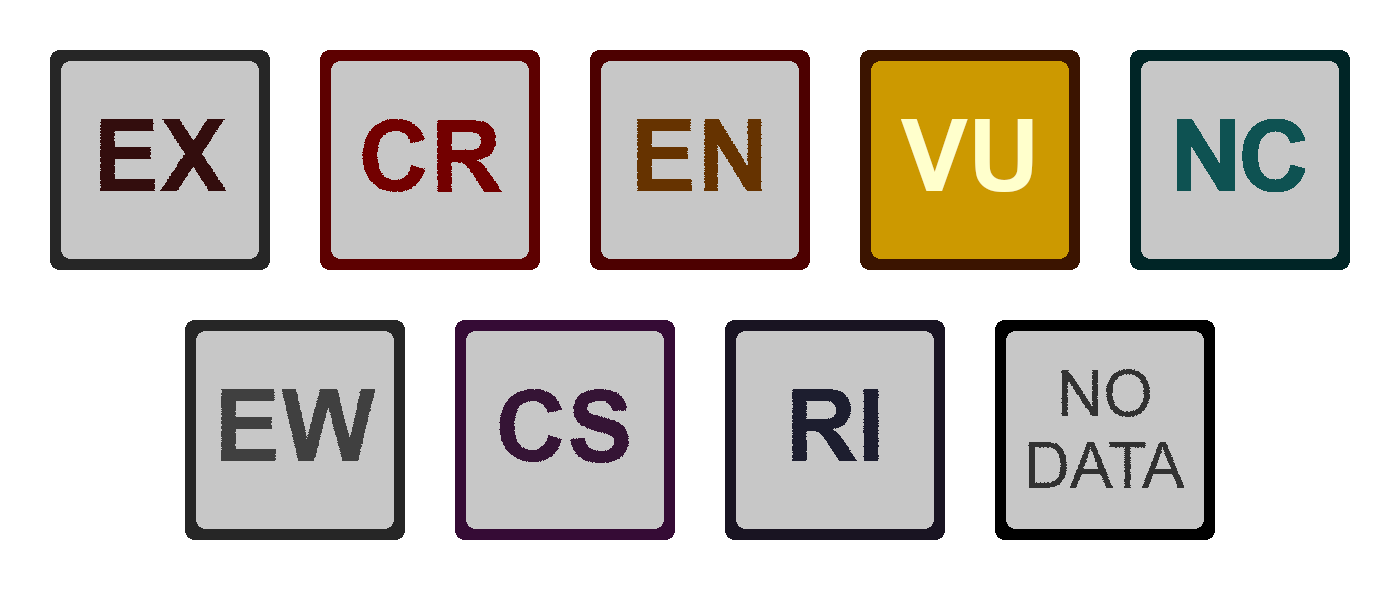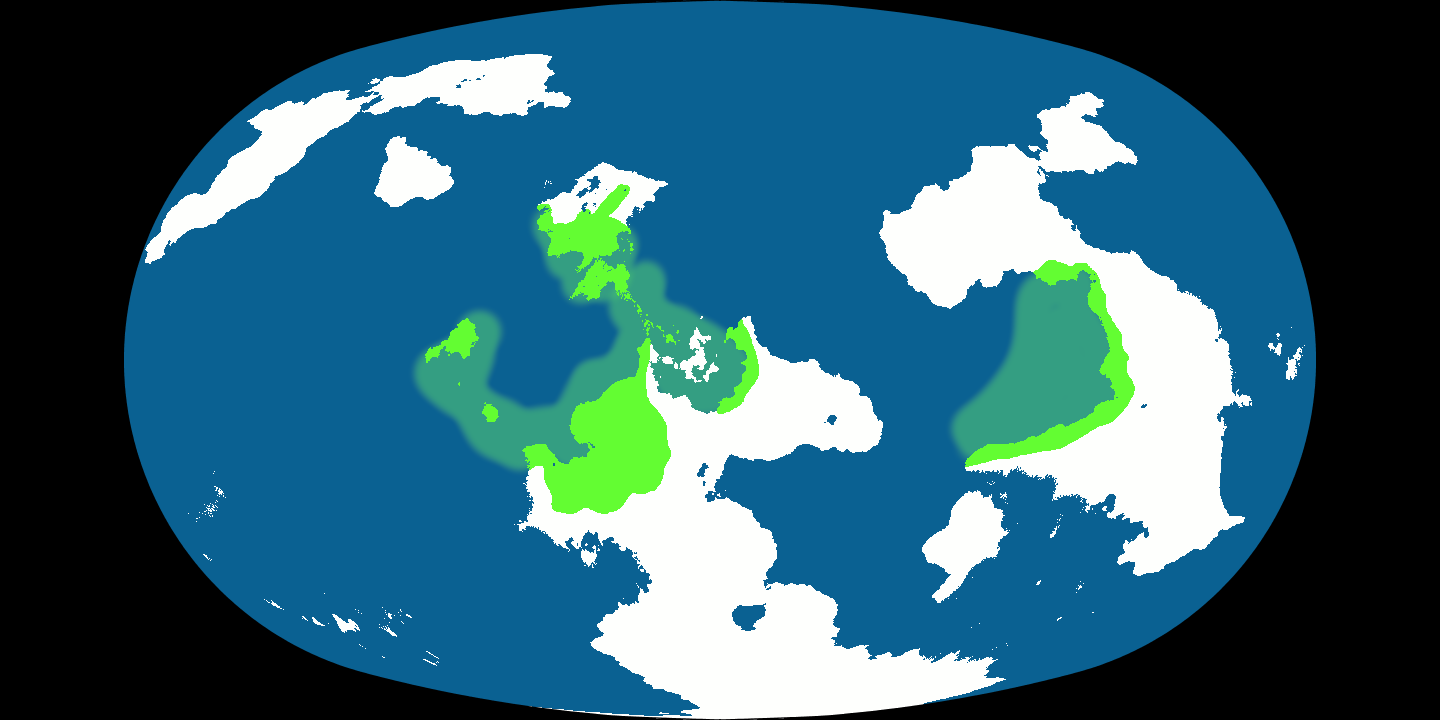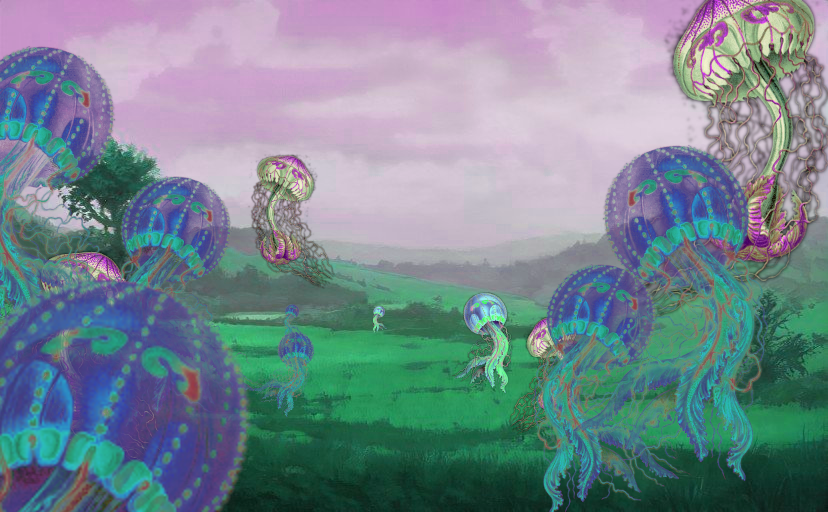Characteristics
Gorshegra are characerized by their colonial structure and symbiotic relationship between different species. Each separate part of the creature, while superficially resembling the parts of a true jellyfish or a man o' war, are entirely separate species of animals, and many of them can actually survive individually or in colonies on their own, and can form colonies with other compatible species.
Each Gorshegra is composed of three separate species of animals, a Pneumatophore, a Gastrozooid, and a Dactylozooid. Each are genetically related but grow into vastly different organisms that fill different functions.
Pneumatophore
The large, balloon-like structure on the creature is called a pneumatophore. It holds the gases necessary to stay afloat. They reproduce asexually, budding small bubbles every few weeks that are actually young creatures. They will float away, searching to form their own colonies which requires coming into contact with polyp spores of compatible species.
Often they find a solid surface to stick to. Here it will absorb plant matter and nutrients from the soil, and produce more young, but in this state, it is very weak and unable to defend itself other than a bitter tasting outer surface. If it comes in contact with polyp spores from a compatible species of gastrozooid or dactylozooid, it will inflate itself and stay in the air.
Gastrozooid
The gastrozooid forms long, leaf-like structures in the center of the colony. Its job is to absorb nutrients from whatever it can catch, or what the dactylozooid kills. It will then distribute these nutrients to the Dactylozooid and the Pneumatophore. On its own, it is very efficient as absorbing nutrients from just about anything, but has the least defenses. Gastrozooids reproduce sexually with spores.
Dactylozooid
The dactylozooid is composed almost entirely of nematocysts. These will sting and inject venom in select prey. Dactylozooids are able to tell is the creature it is stinging is a small creature that it (or attached gastrozooids) can digest, or if the creature is too large. If the creature isn't able to be eaten, then it isn't worth the energy to sting. This makes most Gorshegras pretty harmless around Regalti...unless you irritate the creature, then it will not hesitate to inject as much venom into you as possible. Dactylozooids have almost no room for digestive function, and while they can survive on their own, are much better off in a colony. It should ne noted that most Gorshegras outside tropical zones don't actually have Dactylozooids capable of stinging larger prey, or might not even have dactylozooids at all.
Ecology
Some Balloon Jellies have been blown to rather far flung corners of the world, carried off by storms. They can only reproduce in certain conditions though, which restricts them to only four continents at certain latitudes/
Gorshegra can have an impact on the surrounding environment, as in their environments, they are the main creature responsible for keeping populations of insect-like mollusks in check, though this can have the effect of preventing crops from being pollinated. In non-tropical areas, quite a few animals eat balloon Jellies since they are pretty much defenseless, but balloon jellies can reproduce quickly, especially in more humid environments. Some species of
Flying Lizards will hollow out the inside of the Pneumatophore, and make a nest, while smaller ones like Swarming Lizards are perfect snacks for the Gorshegra. Smaller, parasitic Medusozoa will attach to the Gorshegra and might even look like they are part of the colony, but they do not contribute to protecting the colony or gathering food.
The hunting habits of Gorshegra are all the same. They float out in fields waiting for passing creatures to get stuck in the tentacles, almost always by running away from larger predators. The Gorshegra will then either sting the creature to death and start digestion, or just digest the creature immediately. In aquatic areas, the Gorshegra will float just above the surface, but will sink into the water, grasp onto a lot of plants and animals, then float back out of the water to digest its meal.
Status and Conservation
The issue with Balloon Jellies is that unlike Skyshells that have proper laws in place ensuring protection, they have never been regulated, and they are a massive nuissance in agriculture, where they will kill all the creatures responsible for pollinating the fields. They also make several different tasty dishes and are especially popular in Harketh culture, though most cultures like the Bevari and Fevarik don't consume them. Even so, the creatures are often overhunted in many areas across Collena.
This makes the creature have the "Vulnerable" status. Organizations like the Collena Preservation Society are concerned about their disappearance and what it will do to the environment, but no one else cares. Besides, most Regalti have left Collena since the Exodus started over 350 years ago, and nearly all animal populations have significantly recovered since then.
Relationship with Regalti
In non-tropical environments, Regalti tend to either play with them (children), eat them (the Harketh people), or throws rocks or pokes them with a stick or shoots them for fun (literally everyone). In Tropical environments, everyone is encouraged to stay far away from them because their tentacles can leave painful stings and can kill a Regalti or similar alien creature if stung. Even in tropical environments, everyone shoots them for fun.
the most notable and heinous use of Balloon Jellies was during the War of Purges 263 years before Exodus, the Bevarian Empire experimented with venom from a species of Balloon Jelly that no longer exists (they captured every one they could find, causing them to go extinct). The nature of this venom was such that Regalti could no longer change their skin color, and would forever be in their base skin, which could be peach to tan, to yellow or brown, but they could no longer change to red or green or blue or violet.
Due to the very necessary ability of a Regalti to express their emotions through their changing skin color, the Bevari used this as a form of torture and interrogation. They would start with fingers or toes, inject a little venom, which caused extreme pain on top of the permanent disfigurement. They would inject more and more until they got the information they needed. A number of Regalti from that time period under Bevarian Rule had large splotches of permanently damaged yellowed skin. Despite their overwhelming impact on Regalti culture, the Bevari were very messed up individuals centuries ago.








Comments